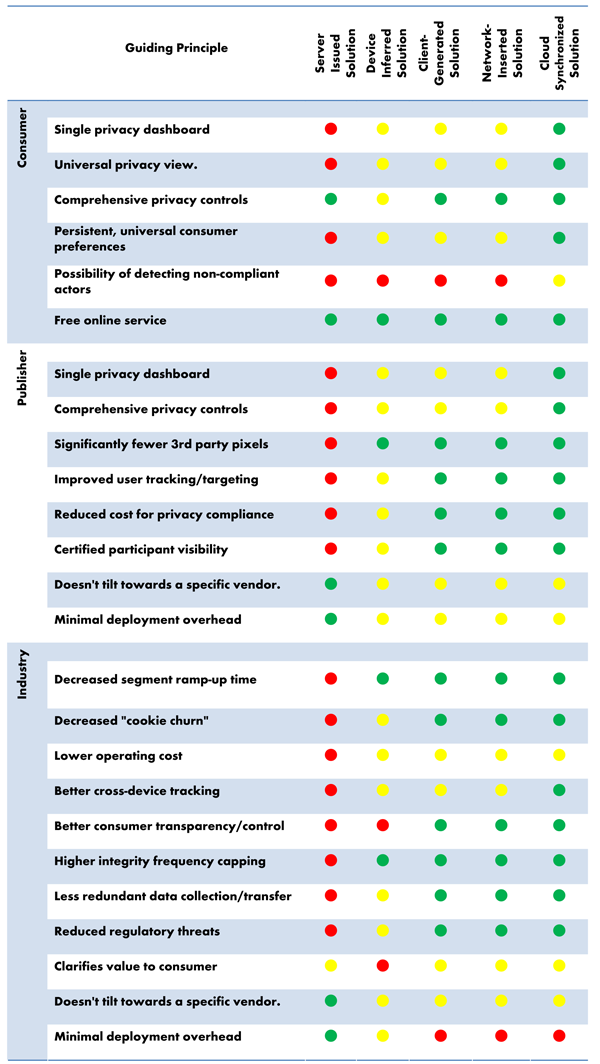IAB Future of the Cookie Working Group and IAB Mobile Marketing Center of Excellence Outline the Limitations of the Traditional Cookie and Identify Potential Solutions
NEW YORK, NY (January 28, 2014) – The cookie has proved to be an effective and efficient solution to many problems, but with the evolution of the internet and new technologies, an over-reliance on the cookie has led to a variety of issues for industry stakeholders and consumers. For this reason, the Interactive Advertising Bureau (IAB) established the IAB Future of the Cookie Working Group in September 2012 to explore alternatives that could more successfully assume the cookie’s vital role. Their findings are now available in the group’s first official output, a whitepaper developed in collaboration with the IAB Mobile Marketing Center of Excellence entitled “Privacy and Tracking in a Post-Cookie World.”
The report investigates several key challenges facing publishers, consumers, and third parties. For online publishers, the proliferation of cookies has slowed page-load times, increased ad discrepancy counts, and led to concerns of data leakage. Cookies have become the focus of many privacy-related debates, and have resulted in a battle among third parties between a rapidly degrading economic model and the costly, persistent, and high-volume deployment of cookies. Furthermore, the growth and diversity of internet-connected devices – from smartphones to tablets and laptops to smart TV’s – have cut into the cookie’s effectiveness, as it cannot track the same user across devices.
With the obstacles defined, the paper establishes the core needs for each participant:
- Publishers
- A single privacy dashboard
- Comprehensive privacy controls
- Significantly fewer third-party pixels
- Improved user tracking and targeting
- Reduced cost for privacy compliance
- Ability to detect non-compliant third parties
- Open competition
- Minimal deployment overhead
- Consumers
- A single privacy dashboard
- A universal privacy view
- Comprehensive privacy controls
- Persistent and universal consumer preferences
- Ability to detect non-compliant publishers or third parties
- Free online service
- Third parties
- Decreased ramp-up time and cookie churn
- Lower operating cost
- Better cross-device tracking
- Better consumer transparency and control
- High-integrity frequency capping
- Less redundant data collection and transfer
- Reduced regulatory threats
- Clear value to the consumer
- A non-proprietary solution not limited to one vendor
- Minimal deployment overhead
The report also identifies five solution classes that could serve as potential replacements for the traditional cookie:
- Device – Uses statistical algorithms to infer users’ IDs from information provided by the connected device, browser, app, or operating system
- Client – The users’ browser, app, or operating system tracks user information and manages preferences, then passes that information along to third parties
- Network – Third party servers positioned between the users’ device and the publishers’ servers set IDs that are used to track user information and manage preferences
- Server – The currently used approach, in which cookies are used to track user information and manage preferences
- Cloud – Tracks user information and manages preferences via a centralized service that all parties agree to work with
A comprehensive chart, presented in the paper, highlights how well each solution class meets the specific needs of publishers, consumers and third parties:

“The cookie has been central to the success of internet advertising,” said Steve Sullivan, Vice President, Advertising Technology, IAB. “However, the industry has evolved beyond the cookie’s designed capability. We at the IAB saw the need to forge a path towards a solution that can more effectively persist consumer preferences, and improve operation performance at the massive scale of today’s digital ecosystem.”
“With the proliferation of internet-connected devices, cookies are an increasingly unreliable tool for tracking users,” said Anna Bager, Vice President and General Manager, Mobile Marketing Center of Excellence, IAB. “Since they cannot be shared across devices, cookies lack the ability to provide users with persistent privacy and preferences as they jump from smartphone to laptop to tablet, and more. At the same time it leaves publishers unable to seamlessly communicate customized content to their audiences on a variety of screens. This report is a first step toward correcting the problem and eliminating one of the biggest limitations impacting mobile advertising today.”
“The digital advertising technology ecosystem is increasingly complex,” said Jordan Mitchell, Rubicon Project Vice President Product and co-Chair of the IAB Future of the Cookie Working Group. “While cookies continue to play an integral role there are many clear signs that change will be required. Over the course of this research, we were able to identify several possible alternatives. Our hope is that this paper will inspire the industry to continue developing a mutually agreed upon solution that meets the needs of all stakeholders.”
To download “Privacy and Tracking in a Post-Cookie World,” please visit here.
About the IAB
The Interactive Advertising Bureau (IAB) is comprised of more than 600 leading media and technology companies that are responsible for selling 86% of online advertising in the United States. On behalf of its members, the IAB is dedicated to the growth of the interactive advertising marketplace, of interactive’s share of total marketing spend, and of its members’ share of total marketing spend. The IAB educates marketers, agencies, media companies and the wider business community about the value of interactive advertising. Working with its member companies, the IAB evaluates and recommends standards and practices and fields critical research on interactive advertising. Founded in 1996, the IAB is headquartered in New York City with a Public Policy office in Washington, D.C. For more information, please visit iab.com.
IAB Media Contact
Laura Goldberg
347.683.1859
[email protected]